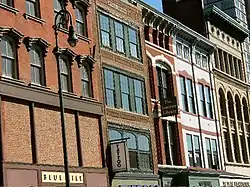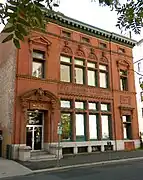Ninth Square Historic District | |
 Facades on Chapel St. between Church St. and Orange St. | |
  | |
| Location | Roughly bounded by Church, State, George, and Court Sts., New Haven, Connecticut |
|---|---|
| Coordinates | 41°18′17″N 72°55′28″W / 41.30472°N 72.92444°W |
| Area | 18 acres (7.3 ha) |
| Architectural style | Late 19th and 20th Century Revivals, Italianate, Greek Revival |
| NRHP reference No. | 84001135[1] |
| Added to NRHP | May 3, 1984 |
The Ninth Square Historic District encompasses a historically diverse and well-preserved part of the commercial area of Downtown New Haven, Connecticut. The district is bounded by Church, Court, State, and Crown Streets, and is centered on the intersection of Chapel and Orange Streets. The buildings in the district are mostly late-19th and early 20th commercial buildings, and includes a number of commercial buildings from the first half of the 19th century, a rarity in most of Connecticut's urban downtown areas.[1][2] The district was listed on the National Register of Historic Places in 1984.
Ninth Square takes its name from an early division of New Haven, when leaders of the New Haven Colony created a town plan of nine large squares in 1637, centered on the one now housing the New Haven Green. Because the ninth square was located closest to the colony's harbor, it was the first to develop a significant commercial presence. In the 1820s, the Farmington Canal was routed near the district, spurring further commercial development. The conversion of the canal right-of-way to railroad use intensified the area's commercial development in the second half of the 19th century. All of this resulted in a significant diversity of styles in the commercial buildings seen, generally reflecting architectural styles popular at the time of their construction. The area declined after World War II, but has been spared from destruction in urban renewal activities of the mid-20th century.[2]
The Ninth Square has been at the center of New Haven's cultural renaissance, densification and renewal over the last decade.
Businesses
| Category | Business names |
|---|---|
| Education & Sharing Economy | A100, Grove, Grove Studios, Gateway Community College, Institute Library, MakeHaven, Project Storefronts, Strive |
| Entertainment | Barcade, CafeNine, Elm City Games, Firehouse 12 |
| Galleries | Artspace |
| Retail | Artist and Craftsman Supply, Ecoworks, English Market, Sportspark |
| Coffee & Cafes | BNatural, Gcafe, Greenwell, Happy Lab |
| Housing | Residences at Ninth Square, 360 State Street |
| Knowledge Economy | Knight Architecture, SeeClickFix, svigals, Veoci, Square Nine Software, DataHaven, MEA Mobile, Patient Wisdom, IDriveYourCar.com, Ovote.com, BetterITS |
| Wellness | Balanced Yoga, Fresh Yoga |
| Restaurants | Pho N Spice, Skappo, Marco Polo, Miso, Tikkaway, Hunan House, 116 Crown, Meat & Co., Trinity |
Gallery
 The Exchange (1832), Chapel and Church Sts., New Haven
The Exchange (1832), Chapel and Church Sts., New Haven Street Building (1832), 742-750 Chapel St.
Street Building (1832), 742-750 Chapel St. Street Building along State St. Monolithic granite piers with Doric capitals marking the original street storefronts.
Street Building along State St. Monolithic granite piers with Doric capitals marking the original street storefronts. Monson Building (1891), 760 Chapel St.
Monson Building (1891), 760 Chapel St. Fire House 12 (1905), 47 Crown St.
Fire House 12 (1905), 47 Crown St. New Haven Water Company (1903), 100 Crown St., Leoni Robinson.
New Haven Water Company (1903), 100 Crown St., Leoni Robinson. Connecticut Savings Bank (1906), 45 Church St., Gordon, Tracy and Swartwout, New York.
Connecticut Savings Bank (1906), 45 Church St., Gordon, Tracy and Swartwout, New York. Orange St. from Center St. to Crown St.
Orange St. from Center St. to Crown St. Young Men's Institute, later the Palladium Building, (1855), 139 Orange St.
Young Men's Institute, later the Palladium Building, (1855), 139 Orange St.
See also
References
- 1 2 "National Register Information System". National Register of Historic Places. National Park Service. March 13, 2009.
- 1 2 Matthew Roth; Bruce Clouette & John Herzan (October 31, 1983). "National Register of Historic Places Inventory-Nomination: Ninth Square Historic District". National Park Service. and Accompanying 28 photos, from 1983, 1989, and undated